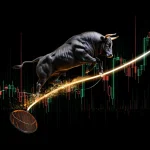In which situation would a savings bond be the best investment? Amidst Panic!
Jan 5, 2025
Introduction: In the Eye of the Storm: When the Panic is Your Ally
The storm is coming. It’s not a question of if but when. When the market roars with fear, and the blood runs cold in the veins of the masses—that is when the savings bond becomes your weapon of choice. In a world where chaos reigns, and disaster looms over every asset class, the savings bond stands as your fortress of stability. This is not about growth; this is about survival. The calm within the chaos is the lighthouse guiding you through the darkness.
The Art of Playing the Long Game in a Short-Term World
At first glance, savings bonds may seem anathema to the fast-paced, high-risk world of modern investing. But those who only seek to chase returns in the market’s most euphoric moments are blind to the true power of these conservative instruments. When fear grips the market—when the herd is stampeding toward the nearest exit—savings bonds offer a calculated refuge. As the market overreacts to panic, bonds act as a silent sentinel, preserving your capital while others frantically scramble.
History has shown time and time again that smart money moves when the crowd is paralyzed by fear. In the heat of market euphoria, when greed intoxicates even the most seasoned investors, it’s easy to forget that the market is cyclical. As the dot-com bubble burst or the housing crash of 2008 demonstrated, there’s always a reckoning. In these moments of market frenzy, the wisest investors, like Charlie Munger, know when to wait, resisting the urge to chase every rising asset. Their patience is their secret weapon, and savings bonds are the strategic reserve they turn to when the market trembles.
Riding the Panic: The Unseen Opportunity
But there’s another side to this coin—when the market collapses under the weight of its panic. When asset prices plummet and fear floods every investor’s mind, you see what separates the men from the boys. In these bleak moments, the savings bond’s true power shines through. It’s not just about the interest—though that’s part of it—it’s about positioning yourself in the eye of the storm. You don’t have to be a hero to win in this game. Sometimes, all it takes is to stand firm while others falter.
In the wake of market bottoms, when the masses have been obliterated by fear and uncertainty, the battle-hardened investor smells blood in the water. The key? Knowing when to transition out of bonds and back into riskier assets—timing the shift when the storm clouds part, and confidence begins to stir once more. This is the domain of seasoned traders like Jesse Livermore, who understood that there is a time for all things. Knowing when to act is the difference between turning panic into profit or getting swept away by the tide.
Jesse Livermore, one of the greatest traders in history, emphasized the importance of timing: “There is a time for all things, but I didn’t know it. And that is precisely what beats so many men on Wall Street who are very far from being in the main sucker class. There is the plain fool, who does the wrong thing at all times everywhere, and the Wall Street fool, who thinks he must trade all the time
Strategic Alternatives to Savings Bonds: The Art of Aggressive Wealth Building
While the masses flee to savings bonds during market crashes, seeking the comfort of 4-5% guaranteed returns, the strategic few deploy capital in ways that can yield 15-40% or more. Here are three powerful alternatives that the wealthy use to build fortunes during market panic:
1. The Premium Harvest Strategy
– Sell cash-secured puts on blue-chip stocks after 20%+ corrections
– Example: During 2020 crash, selling Apple puts yielded 15-20% in premium over 30-60 days
– Risk is owning great companies at crash prices – a risk the wise eagerly accept
2. The Crash Collector’s Method
– Buy quality stocks at panic prices
– Sell covered calls for an additional 15-25% annual yield
– Result: Potential 40%+ annual returns combining appreciation and option premium
3. The Leverage Master’s Approach (For Risk Tolerant)
– Sell puts during peak fear to collect massive premiums
– Use premium to buy long-term call options (LEAPS) on quality stocks
– Potential: Turn $10,000 in put premium into $30,000-50,000 through leveraged recovery
Remember: While savings bonds offer safety, they also guarantee mediocrity. These strategies require more sophistication but can create generational wealth during market panics. The choice between safety and opportunity defines the difference between preserving and creating wealth.
Warning: These strategies require education, discipline, and risk management. But for those willing to learn, they offer returns that savings bonds can never match.
Historical Lessons: Market Cycles and Mass Psychology
The Great Depression provides a stark example of how mass psychology influences investment decisions. As stock market values plummeted, investors flocked to bonds, seeking safety amidst economic turmoil. This period underscored the value of savings bonds as a safe haven during extreme market stress.
More recently, the 2008 financial crisis saw a similar trend of moving into bonds as stock markets plummeted. This flight to quality reflected heightened economic uncertainties and demonstrated how savings bonds can stabilise an investor’s portfolio during turbulent times.
Peter Lynch, the legendary Fidelity fund manager, once said, “Everyone has the brainpower to follow the stock market. If you made it through fifth-grade math, you can do it.” However, he also cautioned against letting emotions drive investment decisions, a particularly relevant lesson when considering savings bonds’ role in a portfolio.
Economic Indicators: The Pulse of Bond Markets
Interest rates and inflation significantly impact the attractiveness of bonds. Typically, a rise in interest rates makes newly issued bonds more lucrative than older ones, offering higher yields. Conversely, during periods of high inflation, the real return on bonds might diminish unless they are inflation-indexed.
Mark Twain, known for his wit and insight, once remarked, “October is one of the peculiarly dangerous months to speculate in stocks. The others are July, January, September, April, November, May, March, June, December, August, and February.” While humorous, this quote underscores the importance of understanding economic indicators and their impact on various investment vehicles, including savings bonds.
The Federal Reserve’s Influence: Monetary Policy and Bond Markets
The Federal Reserve’s monetary policy decisions shape the bond market landscape. When the Fed lowers interest rates, as it did in response to the COVID-19 pandemic, savings bonds can become relatively more attractive than other fixed-income investments. Conversely, in a rising rate environment, the appeal of existing bonds may diminish.
Risk Tolerance and Investment Timeline
An individual’s risk tolerance and investment timeline are pivotal in deciding whether to invest in savings bonds. For instance, individuals nearing retirement might favour the low-risk nature of savings bonds, ensuring capital preservation. Younger investors with a longer time horizon might prefer riskier assets with potentially higher returns, adjusting their bond investments according to life stages and financial goals.
Diversification: The Power of Balance
Ray Dalio, founder of Bridgewater Associates, emphasizes the importance of diversification: “Don’t put all your eggs in one basket.” Savings bonds can play a crucial role in a well-diversified portfolio, offering stability and steady returns to balance out riskier investments.
Bond Characteristics: Understanding the Nuances
Credit quality is a critical factor in bond investment decisions. High-credit quality bonds, such as government securities like savings bonds, offer lower risk and returns than corporate bonds with lower credit ratings. During the 2008 financial crisis, investors flocked to the safety of U.S. Treasury bonds, driving their yields to historic lows. This flight to quality demonstrated the importance of credit quality in times of economic uncertainty.
A bond’s maturity date affects its liquidity and interest rate risk. Longer-term bonds generally offer higher yields but are more sensitive to interest rate changes. When interest rates rise, the value of existing bonds with lower rates decreases, as investors prefer newer bonds with higher yields. This inverse relationship between interest rates and bond prices is a crucial consideration for bond investors.
Strategies from the Masters: Insights for Bond Investors
Benjamin Graham, the father of value investing, advocated investing in securities that offer significant protection against loss. His principles of value investing and the margin of safety are particularly relevant to bond investment, especially when considering savings bonds during market downturns.
Warren Buffett’s long-term investment philosophy aligns well with the nature of savings bonds. His famous quote, “Our favourite holding period is forever,” resonates with the idea of using savings bonds as a stable, long-term component of an investment portfolio.
Conclusion: Seizing Control Amidst the Chaos
The world of investing is not for the faint of heart, and neither is the path of the Viking. When the market descends into panic, when fear drives the masses to make reckless decisions, you must stand tall. Use the storm to your advantage. Just as the Viking warrior capitalized on chaos to expand his power, you too can use market turmoil to fortify your position. Savings bonds become your shield in these moments, preserving your capital and waiting for the opportune moment to strike.
Understand this: the market’s psychology is a battleground where the true warriors thrive. When others are losing their minds, you stand firm, leveraging the power of savings bonds to protect your assets and prepare for the next phase of growth. The true master knows that the tides will turn—and when they do, you will be ready.
Mark Twain says, “It’s not what you don’t know that kills you; it’s what you know for sure that ain’t true.” This sentiment reminds us of the importance of continuous learning and adaptability in the ever-changing landscape of investments, including the strategic use of savings bonds in our financial portfolios.













